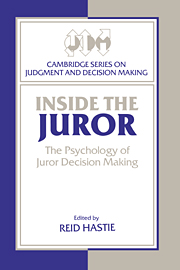Book contents
- Frontmatter
- Contents
- Series preface
- List of contributors
- Editor's preface
- Acknowledgments
- Part I Models of juror decision making
- 1 Introduction
- 2 Some steps between attitudes and verdicts
- 3 The influence of outcome information and attitudes on juror decision making in search and seizure cases
- 4 Algebraic models of juror decision processes
- 5 Stochastic models of juror decision making
- 6 Formal and empirical research on cascaded inference in jurisprudence
- 7 Argument structuring and evidence evaluation
- 8 The story model for juror decision making
- Part II Commentaries
- Index of names
- Index of subjects
5 - Stochastic models of juror decision making
Published online by Cambridge University Press: 04 August 2010
- Frontmatter
- Contents
- Series preface
- List of contributors
- Editor's preface
- Acknowledgments
- Part I Models of juror decision making
- 1 Introduction
- 2 Some steps between attitudes and verdicts
- 3 The influence of outcome information and attitudes on juror decision making in search and seizure cases
- 4 Algebraic models of juror decision processes
- 5 Stochastic models of juror decision making
- 6 Formal and empirical research on cascaded inference in jurisprudence
- 7 Argument structuring and evidence evaluation
- 8 The story model for juror decision making
- Part II Commentaries
- Index of names
- Index of subjects
Summary
Stochastic models, models that characterize processes as probabilistic or chance events, have been applied fruitfully to describe many psychological phenomena. The word stochastic derives from a Greek root that means random, chance, or haphazard. In scientific usage, the antonym for stochastic would be certain or deterministic. While a deterministic model (for example, an algebraic model such as those based on Information Integration Theory) predicts a single response from a given stimulus situation, a stochastic model predicts a set of possible responses weighted by their probabilities of occurrence. It is often useful to think of stochastic models as represented metaphorically by mechanical devices such as decks of cards, roulette wheels, or dice.
Models that describe some aspects of human behavior in probabilistic terms have been applied to simple choice behavior (Luce, 1959), elementary perception and judgment phenomena (Green & Swets, 1966), and simple learning (Estes, 1959). These applications have been extremely successful in describing and predicting human behavior. The probabilistic components in the models may at some basic level of analysis (perhaps physiological) provide an accurate depiction of the underlying physical process. Furthermore, the stochastic component serves as a vehicle to generalize an account of behavior across diverse processes, individuals, or stimulus conditions (Cotton, 1982). For example, in the legal domain, it seems natural to conceptualize the diverse range of cases to which a juror might be assigned as a distribution of potential stimulus events that vary in strengths of evidence favoring one side or the other of each case.
- Type
- Chapter
- Information
- Inside the JurorThe Psychology of Juror Decision Making, pp. 116 - 135Publisher: Cambridge University PressPrint publication year: 1993
- 11
- Cited by



